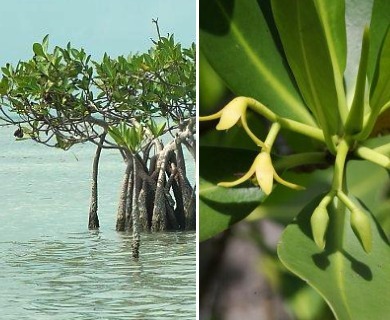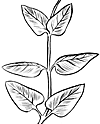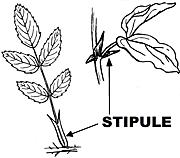American Mangrove
Rhizophora mangle
American Mangrove family (Rhizophoraceae)
Post-Cook introduction
This species, naturalized on protected muddy seashores, is easily recognized by the mass of peculiar branching curved and arching stilt roots that enable the trees to spread in shallow salt and brackish water and form dense, impenetrable thickets at tide level. Each supports an attached odd cigarlike seedling that elongates hanging down.

©2010 Shirley Denton
Leaves crowded at end of twig, hairless, with slightly flattened leaf-stalks of 1⁄2–7⁄8 inch (13–22 ). Blades elliptical, 2 1⁄2–4 inches (6–10 ) long, blunt-pointed at and short-pointed at base, slightly rolled under at edges, slightly leathery and fleshy with side veins not visible, shiny green above, yellow green beneath.
Flowers, usually 2–4, together at leaf base on forked green stalks altogether 1 1⁄2–3 inches (4–7.5 ) long, slightly fragrant, pale yellow, about 3⁄4 inch (2 ) across. The bell-shaped pale yellow base () less than 1⁄4 inch (6 ) long bears four widely spreading narrow pale yellow almost 1⁄2 inch (13 ) long, leathery and four narrow petals 3⁄8 inch (10 ) long, curved downward, whitish but turning brown, white wooly or cottony on inner side; eight and of two-celled mostly inferior but conical at with two ovules in each cell, slender and two-
are dark brown, conical, about 1 1⁄4 inches (3 ) long and 1⁄2 inch (13 ) in diameter, with enlarged curved remaining attached. The single seed germinates inside forming long narrow first root (radicle) green except for brown enlarged and pointed end, to 1⁄2 inch (13 ) in diameter. When about 8–12 inches (20–30 ) long, the heavy seedling falls into the mud or water. It may be carried by water and ocean currents before becoming firmly rooted. Flowering and fruiting continue through the year.
The sapwood is light brown, heartwood reddish brown or dark brown. The wood is hard, very heavy ( gr. 0.9–1.2), durable in the soil but susceptible to attack by dry-wood termites.
Elsewhere, it is used as roundwood for posts and poles and is excellent for fuel and charcoal. Wood in larger sizes has been employed also for marine piling and wharves, shipbuilding, and in cabinet work. The bark is important commercially in tanning leather, and the leaves are rich in tannin also. A dye and medicines have been obtained from the bark. Fishermen in Puerto Rico preserve their lines with an extract from the roots.
Mangrove forests on depositing shores aid in extending the shoreline, holding the black mud in place and gradually advancing on the side toward the ocean. Where native, this species with its stilt roots growing in shallow water extends farther seaward than mangroves of a few other plant families.
Planted and naturalized in salt marshes of Kauai, Oahu, Molokai, Lanai, and Hawaii. Trees can be seen from the bridge at Heeia, as well as the shoreline reefs of Kaneohe Bay and Leeward Molokai.
Champion
Height 61 ft (18.6 ), c.b.h. 3.7 ft (1.1 ), spread 23 ft (7.0 ). Kohana-iki, Kailua-Kona, Hawaii (1968).
Range
Widely distributed on sift shores of the Atlantic Coast of tropical America from Florida, Bermuda, and Bahamas through West Indies and from northeastern Mexico to Brazil. The same or closely related species also on Pacific Coast from northwestern Mexico to Peru, on coasts of western Africa, and in Melanesia and Polynesia.
Other common names
red mangrove, common mangrove, American mangrove; mangle, mangle colorado (Puerto Rico, Spanish)
Botanical
Rhizophora mangle var. samoensis Hochr., R. samoensis (Hochr.) Salvoza
Where necessary to distinguish other unrelated mangroves of seashores, this species is known as red mangrove.
Red mangrove was first introduced to Hawaii in 1902, according to Degener (1933-1986), to hold the soil in the mudflats of southwest Molokai. It has become thoroughly naturalized there. Twenty years later, this and other mangroves were planted in salt marshes of Oahu. Classed also as a weed, often spreading into fish ponds, where eradication is difficult (Hasselwood and Motter 1966).





